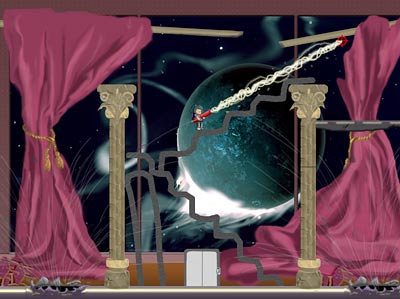Angry Bunny, Squidget Snatcher and others showcase ingenuity at computer game expo
By Bill Steele

Computer games created by Cornell students may not always offer the sophisticated graphics of commercial games, but they often lead in ingenuity and whimsy, as an overflow crowd discovered at the annual showcase of the Game Design Initiative at Cornell (GDIAC), May 14 in the ACCEL computer lab in Carpenter Hall.
Most of the games on display were created in the course Introduction to Game Design, and the showcase was not just for fun; it also served as the final exam. Players' reactions to the games are part of the students' final grade, said computer science research associate Walker White, director of GDIAC, who circulated through the crowd interviewing players. The showcase drew Cornell students and local residents, including a few grade-school kids.
Students who complete the course may go on to workshop courses where they refine their games and develop a portfolio to present to potential employers. Typically, White said, about half of the 50 students who take the beginning course go on to advanced classes, and about 10 of those will find jobs in the gaming industry. Others find the project team experience in the course valuable in other fields, he said. In addition to computer science students, artists and musicians enroll in the course, and team up with programmers to create the games.
"Innovation is required," White noted. Anything that emulates a popular commercial game will get a D, he said. This year's showcase offered fewer shoot-em-ups and more "puzzle games," where players have to solve problems to achieve some goal.
"Crisis at Swiss Station" requires the player to move steel from one part of a space station to another to make repairs. The name comes from the fact that the game begins with the station full of holes. In "Squidget Snatcher," inspired by the minions in the movie "Despicable Me," players capture critters that can be transformed into tools to solve problems. "Memori," a game for the Xbox, lets players freeze moments of the game to bring back later and use to get out of trouble.
For those who want something more aggressive, "Angry Bunny," a game for Android phones, sends the title character on an outer-space quest to recharge batteries (remind you of anyone?) while fighting space raccoons. The game was conceived and named before anyone had heard of "Angry Birds," its creators said. If anything, there might be echoes of the Incredible Hulk, since the bunny becomes invincible when it's angry.
"Dodge, Dip, Duck, Dive and Dodge," a game for the iPhone and iPad, represents the ultimate nerd's revenge for dodgeball, as the protagonist uses a teleporter to avoid ball-throwing bullies. Anime fans will notice that the game uses foreshortened "chibi" characters common in Japanese video games.
Along with classroom-created games, the exhibition also presented "Terra-D.A.C.T.Y.L," a game created from scratch in a 48-hour marathon at a "game jam" competition at the Rochester Institute of Technology. Presenting a message about sustainability, the game lets multiple players collaborate to terraform a planet. The Cornell team won second prize in the competition.
Most of the new games, along with those from earlier years, will be available for download from the GDIAC site at http://gdiac.cis.cornell.edu/. Games for Apple platforms will be available only to the Cornell community.
Media Contact
Get Cornell news delivered right to your inbox.
Subscribe